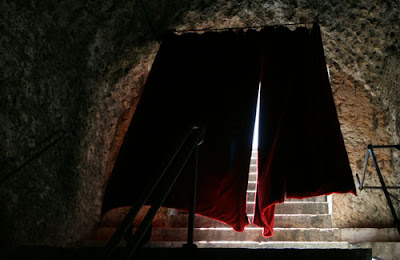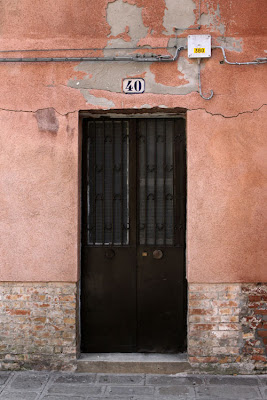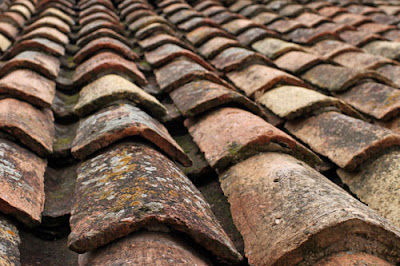 One thing that I don’t share often are images of signs. There are so many different signs here in Europe that you just don’t see in the US, many of them with these pseudo stick figures displaying unacceptable behaviors. It’s amazing how much you can convey with a simple little psuedo-stick figure. Maybe it’s because there are so many cultures and languages all mixed up here, a picture is the most effective way to convey information quickly. Today’s image is one example that I found very amusing, from a German train station. If common sense weren’t enough to keep you from the edge of the platform, and if you don’t read German, here you go. Now you’re safe.
One thing that I don’t share often are images of signs. There are so many different signs here in Europe that you just don’t see in the US, many of them with these pseudo stick figures displaying unacceptable behaviors. It’s amazing how much you can convey with a simple little psuedo-stick figure. Maybe it’s because there are so many cultures and languages all mixed up here, a picture is the most effective way to convey information quickly. Today’s image is one example that I found very amusing, from a German train station. If common sense weren’t enough to keep you from the edge of the platform, and if you don’t read German, here you go. Now you’re safe.
Archives for July 2010
A Taste of Switzerland
Road Trip ’09 from Kat Sloma on Vimeo.
Heading to Switzerland this week reminded me of our road trip last year, when we first visited this beautiful country. We decided that the four or so days we spent there were not enough time, that’s why we’re going back! I thought I would share this photo story again of our road trip last year, to give you a taste of Switzerland along with Germany, Austria and Slovenia. I look forward to sharing more new images next week!
‘Tis the Season
 Ah, summer. A time of grassy green fields and abundant flowers. A time of heat and humidity; long, lazy days exploring the world. This image is a summer vacation image, from outside of Amsterdam last year. I love the peaceful, country feel of it. Don’t you just want to find a patch of grass under a shady tree near here and enjoy the afternoon? Maybe with a book along, a cool drink and of course, a camera. That is happiness.
Ah, summer. A time of grassy green fields and abundant flowers. A time of heat and humidity; long, lazy days exploring the world. This image is a summer vacation image, from outside of Amsterdam last year. I love the peaceful, country feel of it. Don’t you just want to find a patch of grass under a shady tree near here and enjoy the afternoon? Maybe with a book along, a cool drink and of course, a camera. That is happiness.
Summer is also the time of vacations, and we are going on one yet again. Tonight we leave for a week in Switzerland, so I’ll be disappearing from here for a bit while I go capture new images of new places. I love it! So much creative fuel. I’ve scheduled a couple of posts for next week so check back – or sign up for the site feed if you haven’t already, since that’s the easiest way to get updated when there are new posts.
Until I’m back, happy travels to all!
Exploring with a Camera: Thresholds
 Time for another exploration! This time of a subject: Thresholds. By “threshold” I’m not referring to any technical term, but a physical place. A place where you cross over, from one locale to another, whether real or imagined. Threshold images are not merely images of doors or gates, but they are of portals that transport you to somplace different in your imagination.
Time for another exploration! This time of a subject: Thresholds. By “threshold” I’m not referring to any technical term, but a physical place. A place where you cross over, from one locale to another, whether real or imagined. Threshold images are not merely images of doors or gates, but they are of portals that transport you to somplace different in your imagination.
The photo above is an example of the type of “threshold” I am talking about. This image is from the Roman Arena in Verona. When I look at it, I get a sense of time travel. In my imagination, if I walk through that curtain, I will be transported back to Roman times. There is a magical quality of the unknown on the other side of that curtain. It beckons me to come through.
Here is another, of a gate to Parco di Monza near my home. This image gives me the feeling of looking into another world, some sort of magical winter wonderland. The gate is merely the portal, the threshold to this place. I want to explore down that path.
And here is a threshold that I captured that has become sort of an anti-threshold to me. One that I don’t plan to pass through. You see, later this year I turn 40 years old and I started looking for places with the address 40 to capture my threshold. This image is from the island of Murano in the Venetian lagoon, one of my favorite places on earth to photograph, but this is one of the most depressing images I have photographed there. After I reviewed and edited it, I realized that is not my 40 threshold at all – there is no hope, no happiness, no creativity in this threshold. It’s pretty bleak and closed off. It showed me that I have no problem with turning 40, that I reject the idea that this milestone is a bleak thing. So there is power in that too – I began to imagine what my internal 40 threshold looks like and it’s nothing like this.
To capture a special threshold image, here are some tips:
1. Look for doors or gates that have some contrast in what is behind versus what is part of the wall or structure the opening is in. This could be a contrast in light or in scenery. The greater the contrast, the greater the opportunity for the “threshold” feeling.
2. Try getting in close to the threshold. By cropping in close on the opening so you don’t see what is surrounding it, you create more opportunity for creative story telling because there is not as much physical “place” presented to distract the imagination with reality.
3. Look for openings that are not fully open, that just give a hint of what is behind them. This will give a tantalizing, magical feeling. In this case, the imagination is not distracted by the reality of what is on the other side of the threshold, but is allowed to go wild.
4. Look for thresholds that have meaning to you, whether it’s the address number or the physical place or the imagery you find there. Later, take some time to examine that image to see what meaning you find. Does the image match your imagination or feelings? Why or why not? Can this threshold be useful to you to learn something about yourself?
Photography, like any art, is symbolic. The images we capture have meaning, whether or not we know it at the time. Explore the world around you with the idea that there are magical thresholds available to you all the time, and share what you find! Post a link to your photo here in the comments or join the Flickr group set up for my Exploring with a Camera series.
Why Windows?
 An attractive set of windows in Dubrovnik caught my eye. As I was editing this photo and others from this day I wondered, why windows? Why do they catch my eye so? Especially ones with plants and flowers in them. Ones like this, with interesting bars to cover them too.
An attractive set of windows in Dubrovnik caught my eye. As I was editing this photo and others from this day I wondered, why windows? Why do they catch my eye so? Especially ones with plants and flowers in them. Ones like this, with interesting bars to cover them too.
Maybe it’s because of the individuality of each of them. Each window is different, unique, has a history of its own. The decorations reflect the individuality of the owners, no two are alike. They are an outward display of the lives inside. So much of peoples lives is closed inside here in Europe – inside the shuttered windows and big solid doors – that this is a little glimpse that there is someone living in there. And someone there who cares to make their place look pretty on the outside, even if the only way to do that is to decorate the window. Not for the tourists, but for themselves and their neighbors, the people who will enjoy it every day.
And I get to enjoy these windows, to photograph them, and to share them with you. Thanks to all of these anonymous people, who make my images possible. They are the true artists here!
The Story in the Rooftops
 There is a story in the rooftops of Dubrovnik. A history, there for the eyes to see. Not the history of hundreds of years ago, but of less than two decades. A story from the Croat-Serb conflict of 20 years ago.
There is a story in the rooftops of Dubrovnik. A history, there for the eyes to see. Not the history of hundreds of years ago, but of less than two decades. A story from the Croat-Serb conflict of 20 years ago.
Shortly after Croatia declared independence from Yugoslavia, Dubrovnik was beseiged for seven months as part of the conflict, in 1991-1992. The idea was that breaking Dubrovnik would break the spirit of the Croatian conflict. But Dubrovnik was never broken, and neither was the spirit of the Croats. This city survived, as it has survived for centuries, even against major powers like the Venetians. And now it is rebuilt, the damaged rooftops and streets repaired to invite visitors once again. So Dubrovnik has an interesting look, because of all of this, with most of the centuries-old buildings sporting new rooftops. You can see the difference between the ones from long ago and the ones that are brand new. You can see the spirit of the people who survived and defended their city in modern times. You can hear it in the stories of the people you talk to… from the restaurant owner who tried to teach us to make a whistle with our hands “like they used to communicate in the war” to the owner of the apartment we rented who told us how the old aqueduct system bringing water to the town worked even during the conflict.
So Dubrovnik has an interesting look, because of all of this, with most of the centuries-old buildings sporting new rooftops. You can see the difference between the ones from long ago and the ones that are brand new. You can see the spirit of the people who survived and defended their city in modern times. You can hear it in the stories of the people you talk to… from the restaurant owner who tried to teach us to make a whistle with our hands “like they used to communicate in the war” to the owner of the apartment we rented who told us how the old aqueduct system bringing water to the town worked even during the conflict.
There is pride in these stories, pride in the rooftops. They respect the history of the town, and it becomes intertwined with these recent histories and experiences. In some places, you see where they tried to repair the roofs with as many old tiles as possible, combining them with new. It all becomes one continuous history. And when you look out over the town, you get a visible reminder that conflict is not gone from our world. But it can end, people can rebuild and in the course of less than a lifetime go from besieged town to thriving tourist destination. Dubrovnik was a beautiful city, well worth the visit. But I think what I liked best, was hearing the story of the people who live there and reading the story in the rooftops.
And when you look out over the town, you get a visible reminder that conflict is not gone from our world. But it can end, people can rebuild and in the course of less than a lifetime go from besieged town to thriving tourist destination. Dubrovnik was a beautiful city, well worth the visit. But I think what I liked best, was hearing the story of the people who live there and reading the story in the rooftops.
